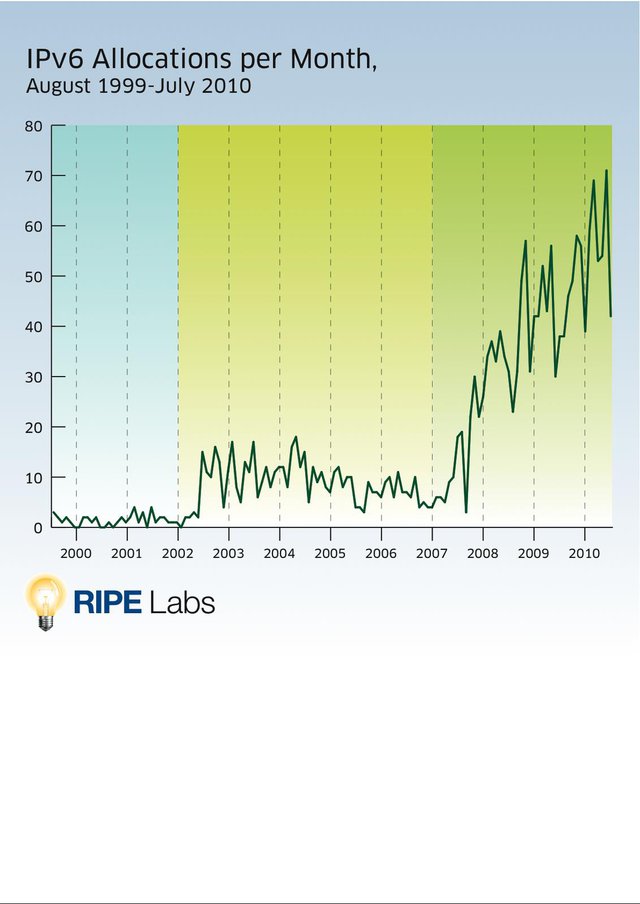The graph shows the number of IPv6 allocations made by the RIPE NCC to its membership since 1999.
The graph below illustrates the three phases that have defined the RIPE community’s journey to IPv6 deployment: the Experimental Phase from 1999-2002, the Early Adopters Phase from 2002-2007, and the Deployment Phase from 2007 – present day and beyond.

Experimental Phase: 1999-2002
For the RIPE NCC, the journey to IPv6 began in 1999 when, together with the other RIRs (ARIN and APNIC at the time), we started to allocate IPv6 address space to the membership. This resulted in the first policy (as later agreed by the community and published as RIPE document 196 ) which helped to create IPv6 awareness amongst the community. Soon after, the RIRs began handing out /35s to experimental networks and early adopters. It was also decided by the RIR communities to implement a “Bootstrap Phase” which offered relaxed allocation criteria until 100 organisations had received IPv6 address space (with not more than 60 in one region). It turned out that the RIPE NCC members were the fastest to request IPv6 allocations, so the Bootstrap Phase wasn't in place for very long.
Early Adopters Phase: 2002-2007
After some years of experience with allocating IPv6 address blocks, the original policy was revised and republished as RIPE document 246 in June 2002. In this new document the so-called HD ration was introduced to measure the utilisation of IPv6 allocations, the minimum allocation size was set to a /32 and a totally new initial allocation criteria was set: an organisation had to be an Internet Service Provider, not an End Site. That means that the recipient had to plan to provide IPv6 connectivity to customers to which it would assign /48s. In addition, the ISP had to have a plan for making at lease 200 /48 assignments to other organisations within two years. This phase is when we see the first significant increases in IPv6 allocation, as you can see on the graph.
Deployment Phase: 2007-Present
The first spike in IPv6 requests made to the RIPE NCC started in 2007, the same year that the RIPE community expressed its support for widespread deployment of IPv6. This was also when the RIRs began to warn that IPv4 addresses were running out soon. If you look at the last few years on the chart, you’ll see a sharper increase in the amount of IPv6 allocations from the RIPE NCC, as understanding to deploy IPv6 grows.
The regular dips in the graph in the middle of each year represent the summer month in which business usually slows down in Europe. A similar, but not as significant dip is visible at the end of each year. This normally results in peaks immediately after these slower periods.
As of July 2010, only 6% of IPv4 address space remains, yet a large portion of ISPs and enterprises still lag behind in IPv6 deployment. The RIPE NCC would urge all organisations to prioritise IPv6 deployment to ensure the continued growth of the Internet and their businesses.





Comments 0
The comments section is closed for articles published more than a year ago. If you'd like to inform us of any issues, please contact us.